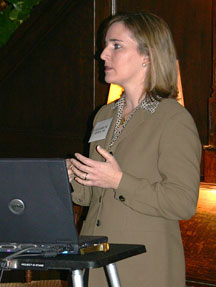

Campus Hosts Science and Immigration Forum
By Mika Ono
It's no secret that science today is an international endeavor. Collaborations span the globe. Scientists routinely cross borders to attend conferences, train with pioneers in their fields, and participate in highly specialized research teams.
But these days, crossing borders is not always easy. On a day-to-day basis, The Scripps Research Institute's International Office helps the institute's scientists navigate the maze of immigration and visa procedures and regulations with the aim of helping researchers produce their best work.
Last week, the International Office went a step further, hosting an event that focused on improving communication between scientific institutions and U.S. immigration agencies. Bringing together some three dozen people representing both leading research institutions and the officials who decide their scientists' cases, the event promoted dialog and understanding between the two groups.
"Our goal was educational," said Thomas Barnett, director of the Scripps Research International Office. "It was a chance for us to explain basic things about the scientific world—such as the pressures scientists face, how grant funding is obtained, how research teams are organized, and what titles such as 'research associate,' 'assistant professor,' and 'principal investigator' actually mean."
In addition to Barnett and the International Office team, participants included representatives from the Salk Institute for Biological Studies, the University of California, Berkeley, Duke University Medical Center and Health System, the California Institute of Technology, Lawrence Livermore Laboratory, and the University of Southern California, as well as adjudicators from the Department of Homeland Security's Citizenship and Immigration Services and members of its Ombudsman's Office.
The morning of the October 27 event brought participants together on Scripps Research's La Jolla campus for presentations and discussions. After an informal lunch, the group went on laboratory tours. At the Salk Institute, Professor Juan Carlos Izpisúa Belmonte explained his research on how genes and molecules orchestrate the development of an embryo.
Back at Scripps Research, Assistant Professor Gaudenz Danuser, whose laboratory focuses on the molecular regulation of cell migration and chromosome segregation, presented ongoing research relevant to the treatment of cancer. Next, Associate Professor Ulrich Mueller shared some of his findings on the genetic underpinnings of some forms of deafness, offering participants the chance to view images with an electron micrograph.
While immigration personnel learned about science, representatives of the research institutions deepened their understanding of the challenges that face immigration officials. "Officials must follow the rules that Congress passed—that's the nature of the job," said Barnett, who also serves as a member of the Citizenship and Immigration Service's Ombudsman's Task Force. "In addition, they have to work with limited resources."
Scripps Research Immigration Advisor Kim Jackson, who toured the Citizenship and Immigration Service's California Service Center in Orange County earlier in the month as part of a professional conference, emphasized the massive scale of the Citizenship and Immigration Services task. "The California Service Center's mail room, with upwards of 500 employees, looks like a shipping yard," she said.
Barnett hopes that the Scripps Research event and others like it will to help promote a spirit of cooperation and problem solving between research institutions and immigration officials. "Our meeting needs to be part of an ongoing effort," he said. "For better or worse, immigration law, personnel, and agencies are a moving target."
Send comments to: mikaono[at]scripps.edu

Elizabeth Krider of the California Institute of Technology explains some of the fundamentals of the scientific world.
